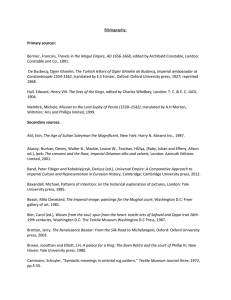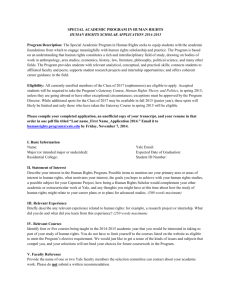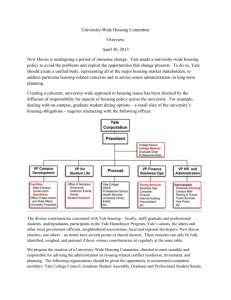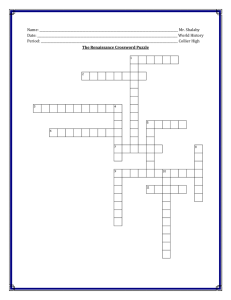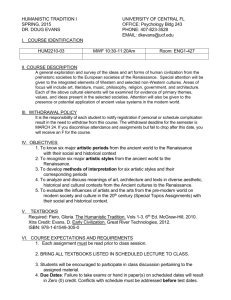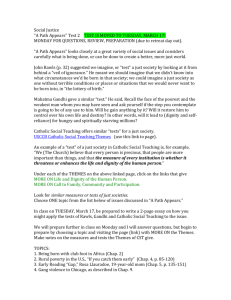Nicola Courtright Spring 2012
advertisement
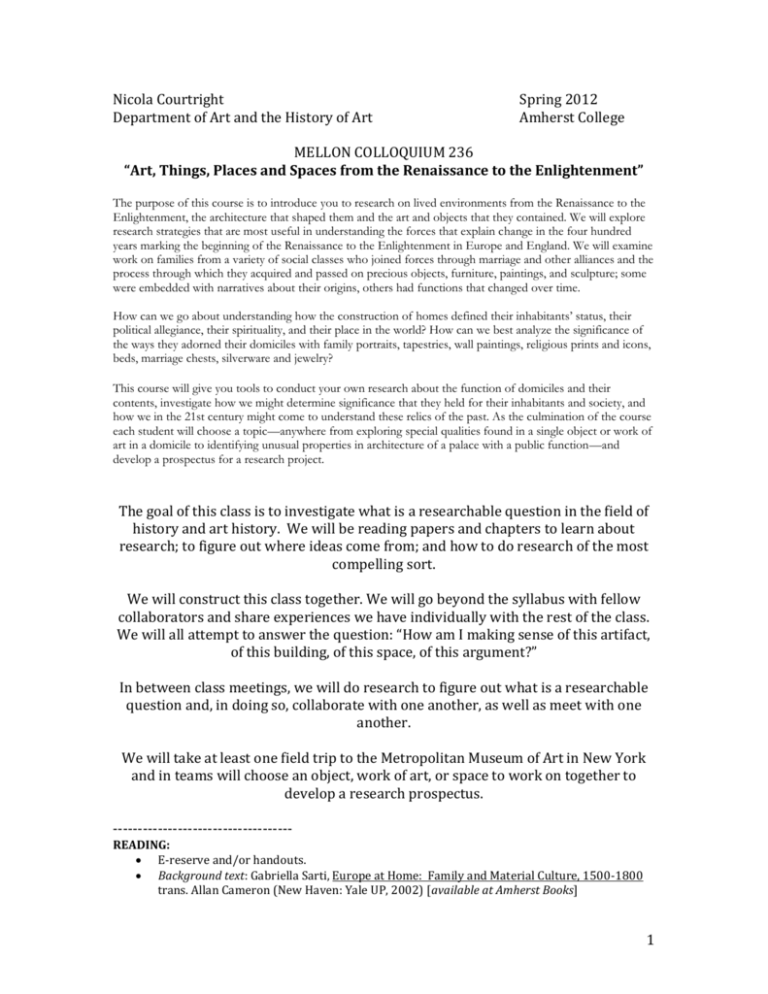
Nicola Courtright Department of Art and the History of Art Spring 2012 Amherst College MELLON COLLOQUIUM 236 “Art, Things, Places and Spaces from the Renaissance to the Enlightenment” The purpose of this course is to introduce you to research on lived environments from the Renaissance to the Enlightenment, the architecture that shaped them and the art and objects that they contained. We will explore research strategies that are most useful in understanding the forces that explain change in the four hundred years marking the beginning of the Renaissance to the Enlightenment in Europe and England. We will examine work on families from a variety of social classes who joined forces through marriage and other alliances and the process through which they acquired and passed on precious objects, furniture, paintings, and sculpture; some were embedded with narratives about their origins, others had functions that changed over time. How can we go about understanding how the construction of homes defined their inhabitants’ status, their political allegiance, their spirituality, and their place in the world? How can we best analyze the significance of the ways they adorned their domiciles with family portraits, tapestries, wall paintings, religious prints and icons, beds, marriage chests, silverware and jewelry? This course will give you tools to conduct your own research about the function of domiciles and their contents, investigate how we might determine significance that they held for their inhabitants and society, and how we in the 21st century might come to understand these relics of the past. As the culmination of the course each student will choose a topic—anywhere from exploring special qualities found in a single object or work of art in a domicile to identifying unusual properties in architecture of a palace with a public function—and develop a prospectus for a research project. The goal of this class is to investigate what is a researchable question in the field of history and art history. We will be reading papers and chapters to learn about research; to figure out where ideas come from; and how to do research of the most compelling sort. We will construct this class together. We will go beyond the syllabus with fellow collaborators and share experiences we have individually with the rest of the class. We will all attempt to answer the question: “How am I making sense of this artifact, of this building, of this space, of this argument?” In between class meetings, we will do research to figure out what is a researchable question and, in doing so, collaborate with one another, as well as meet with one another. We will take at least one field trip to the Metropolitan Museum of Art in New York and in teams will choose an object, work of art, or space to work on together to develop a research prospectus. -----------------------------------READING: E-reserve and/or handouts. Background text: Gabriella Sarti, Europe at Home: Family and Material Culture, 1500-1800 trans. Allan Cameron (New Haven: Yale UP, 2002) [available at Amherst Books] 1 SYLLABUS [to be altered if we think it’s necessary] 1/26 1. BASIC PRINCIPLES a.) Finding out facts: a. WHO executed the object/ designed the space and for WHOM? b. WHAT does it represent? c. WHEN was it done? d. WHERE was it originally located? e. HOW was it executed? (what medium) b.) Going beyond the facts toward a researchable question. Interpretation of facts is one of the most exciting and loaded enterprises in humanist scholarship. Not all historians agree on the goal of interpretation, and we will examine different views. Here are some methods to posit some of our own interpretations: We will scrutinize sources. We must judge the facts. We will consider the different purposes of primary sources, and how they might or might not help us in thinking about what the purpose of an object/space was close to the time in which it was constructed. o How reliable are they? o Do sources help us craft interpretations about functions or purposes of objects/spaces later in their history We will look at visual evidence, and determine what exactly constitutes evidence. We will look for change over time in one object/space/ and another that is similar in genre or type. We will consider how we judge the difference of one object/space from another— o is it the same era or a different one? o Same culture or a different one? and consider on what basis we draw conclusions about these differences. The imponderable question is: what are we looking for? Is it its function or purpose? Is it is significance or what many historians call meaning? How are we making meaning? 2 o If it is the significance of an object/space then the question needs to be narrowed down: signifies what kind of thing: Spiritual? Social? Personal? Political? and to whom? o To us in the 21st century? o To the maker? o To the user when it was first made? To later users? We will have to judge the different ways different authors proffer facts and make interpretations. The chapters and articles we read will interpret art, things, places and spaces or will suggest other forms of understanding historical phenomena. We will look for author’s claims. We will think about which claims are based on facts, and where those facts come from; about interpretations and the kinds of lenses authors use to present and interpret their material. Prime example today-- My obsessions: royal spaces. 2/2 2. 15th-century Florence: Imagery and identity READING: Patricia Lee Rubin, chaps. 1, 2, “The Imagery of Identity,” and “’Dello splendido vivere’: On Necessary and Honorable Expenditure,” in Images and Identity in Fifteenth-Century Florence (New Haven and London, Yale UP: 2007), 3-43. Jules Prown, chap. 13, “The Truth of Material Culture: History or Fiction,” in Art as Evidence: Writings on Art and Material Culture (New Haven and London: Yale UP), 220-34 2/9 3. 15th-century Florence: Imagery and identity in interiors READING: Daniel Roche, Intro., chap. 7, “Furniture and objects,” in A History of Everyday Things: The Birth of Consumption in France, 1600-1800, trans. Brian Pearce (Cambridge: Cambridge UP, 2000), 1-8,16692, 256-57, 275-77 Jacqueline Marie Musacchio, chap. 3, “Chests and Their Contents,” in Art, Marriage, & Family in the Florentine Renaissance Palace (New Haven: Yale UP, 2008), 122-90, 283-92 3 2/16 4. 15th-century Florence: Imagery and identity, cont’d. READING: Georges Didi-Huberman, “Opening up Venus: nudity, cruelty and the dream,” in The Beholder: The Experience of Art in Early Modern Europe, ed. Thomas Frangenberg and Robert Williams (Aldershot: Ashgate, 2006), 37-52Luke Syson, “Representing Domestic Interiors,” in At Home in Renaissance Italy, ed. Marta AjmarWollheim and Flora Dennis (NY: Abrams, 2006), 86-101, 373-4 2/23: NMC is away. Let’s see if we can meet earlier in the week. 5. Devotional images, the portrait, and the body READING: Hans Belting, chap. 3, “The Coat of Arms and the Portrait: Two Media of the Body,” in An Anthropology of Images: Picture, Medium, Body, trans. Thomas Dunlap (Princeton: Princeton UP, 2011), 62-83, 176-9 Ivan Gaskell, “Diptychs--What’s the Point?” in Essays in Context: Unfolding the Netherlandish Diptych ed. John Oliver Hand and Ron Spronk (Cambridge and New Haven: Harvard University Art Museums and Yale UP), 201-212 3/1 6. Courtly preciosity: jewels and exotic objects READING: Marina Belozerskaya, “The Powers of Gold and Precious Stones,” in Luxury Arts of the Renaissance (L.A.: J. Paul Getty Museum, 2005), 46-87, 264 Nicholas Thomas, chap. 4, “The European Appropriation of Indigenous Things,” in Entangled Objects: Exchange, Material Culture, and Colonialism in the Pacific (Cambridge: Harvard UP, 1991), 125-84, 236-49 3/8 7. Picturing Dutch homes in the 17th century READING: C. Willemijn Fock, “Semblance or Reality: The Domestic Interior in Seventeenth-Century Dutch Genre Painting,” in Art and Home: Dutch Interiors in the Age of Rembrandt, ed. Mariët Westermann (Zwolle: Wanders Publishers, 2001), 82-101, 226-7 Heidi de Mare, “Domesticity in Dispute: A Reconsideration of Sources,” in At Home: An Anthropology of Domestic Space, ed. Irene Cieraad (Syracuse: Syracuse UP, 1999), 13-30 3/15 8. Palace and Residence in 17th-century Rome and Paris READING: Patricia Waddy, “Inside the Palace: People and Furnishings,” in Life and the Arts in the Baroque Palaces of Rome: Ambiente Barocco (New Haven and London: Yale UP), 20-37 4 Annik Pardailhé-Galabrun, chap. 4, “Daily Actions in the Privacy of the Home,” in The Birth of Intimacy: Privacy and Domestic Life in Early Modern Paris, trans. Jocelyn Phelps (Philadelphia: UPenn P, 1991), 73-116, 223-4 BREAK 3/29 9. Leisure and authority in 18th-century France READING: Mimi Hellman, “Furniture, Sociability, and the Work of Leisure in Eighteenth-Century France,” Eighteenth-Century Studies, 32 no. 4 (1999): 415-45 Katie Scott, chap. 6, “Framing Ambition: The Interior Politics of Mme de Pompadour,” in Between Luxury and the Everyday: Decorative Arts in Eighteenth-Century France, ed. Katie Scott and Deborah Cherry (Malden: Blackwell, 2005), 110-152 SATURDAY, 4/1—FIELD TRIP TO METROPOLITAN MUSEUM, NYC? From now on, it is YOUR choice what we discuss. To be continued…. 5 4/5 10. 4/12 11. 4/19 12. 4/26 13. 5/3 14. 6
